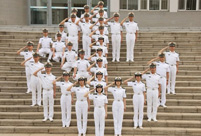 High speed train attendants receive training in Chongqing
High speed train attendants receive training in Chongqing
 Rare rainbow clouds seen in Fujian
Rare rainbow clouds seen in Fujian
 Small bracelet going global
Small bracelet going global
 Aerial Photography: Amazing Tianshan Mountains
Aerial Photography: Amazing Tianshan Mountains
 'Animals' in 2014 World Cup
'Animals' in 2014 World Cup
 Not afraid of death
Not afraid of death
 Chen Guangbiao ads on A15 of NYT to host charity luncheon for 1,000 poor and destitute Americans
Chen Guangbiao ads on A15 of NYT to host charity luncheon for 1,000 poor and destitute Americans
 Passionate bar babies and fans feel the charm of World Cup 2014
Passionate bar babies and fans feel the charm of World Cup 2014
 US aircraft carrier docks in HK, welcomes PLA aboard
US aircraft carrier docks in HK, welcomes PLA aboard
 Graduation season: 'Take graduation photos to mark our love'
Graduation season: 'Take graduation photos to mark our love'
TOKYO, July 1 -- The Japanese Cabinet on Tuesday approved a controversial resolution that will allow the country to exercise the collective self-defense right, an overhaul of Japan's exclusively defense-orientated security policy in postwar era.
But the resolution, which came amid strong opposition, is not a convincing choice made by the Japanese people, but only by Abe and his ruling bloc.
Different poll results released recently all showed that more than half of the respondents opposed Abe's attempt to lift the ban on collective self-defense. They feared the move would drag Japan into war.
Moreover, thousands of people took to the streets recently, protesting against Abe's move. On Sunday, a man even set himself on fire close to the crowded Shinjuku railway station, downtown Tokyo, to show his violent opposition to the government's risky decision.
However, these public sentiments didn't halt the dramatic shift in Japan's postwar security policy. This raises a question -- where does Abe's confidence come from? How could he hijack the nation on his way despite the opposition from the public?
There are three reasons that might explain the move. Firstly, Abe's Liberal Democratic Party (LDP) and its coalition partner New Komeito Party claim a majority both in the Upper House and Lower House. The ruling coalition has a virtually free hand since there is no national election until 2016.
Secondly, the resolution got approval after just one month discussion between the LDP and the New Komeito Party, so there was limited time for people who hold different ideas to react. Though public opposition has been growing recently, it is too late to change the final decision. Abe also used this kind of technique in late 2013 when he sought green light for the "Special Secrecy Law. "
Thirdly, Abe has taken advantage of people's expectation for economic recovery to realize his own political agenda. Since the hawkish leader took office again in late 2012, there have been tentative signs of improvement in the Japanese economy under the policy dubbed as "Abenomics."
People fear that government change will lead to policy adjustment, suspending the upturn trend. In this mentality, some of them chose to support the Abe's Cabinet despite its adoption of aggressive security policy. For Abe, whether his economic policies will be successful in the long term is unknown, so he needs to achieve his ambition before any possible economic downturn.
In seeking to change the nation's basic postwar defense posture, Abe has bypassed the process of amending the Constitution through a prescribed procedure, which requires majority approval in a public referendum following Diet concurrence by two-thirds or more of the lawmakers in each chamber. He deliberately chose to reinterpret the Constitution with a single decision of his Cabinet.
It leaves room for speculation that the Japanese government may further "reinterpret" the Constitution for its own needs. Under this circumstance, the concepts of "constitutionalism" and "the rule of law" in Japan would be gutted.
 Female master poses for graduation photos with son
Female master poses for graduation photos with son Silk Road, China's Grand Canal listed as World Heritage Sites
Silk Road, China's Grand Canal listed as World Heritage Sites PKU students imitate famous paintings in real-person photos
PKU students imitate famous paintings in real-person photos Chinese 'Slumdog Millionaire'
Chinese 'Slumdog Millionaire' Puzhehei: land of idyllic beauty
Puzhehei: land of idyllic beauty Stewardesses in Brazilian soccer jerseys
Stewardesses in Brazilian soccer jerseys Chinese navy fleet visits Cape Town, South Africa
Chinese navy fleet visits Cape Town, South Africa PLA naval cadets toss their hats at graduation ceremony
PLA naval cadets toss their hats at graduation ceremony Graduation photo ideas: reliable alumnus and happy alumna
Graduation photo ideas: reliable alumnus and happy alumna Islands in S. China Sea better shown on new vertical atlas of China
Islands in S. China Sea better shown on new vertical atlas of China Girl takes father’s portrait to travel the world
Girl takes father’s portrait to travel the world Images of Xi'an: Part one
Images of Xi'an: Part one In Pictures: Female fans of World Cup
In Pictures: Female fans of World Cup Top 20 hottest women in the world in 2014
Top 20 hottest women in the world in 2014  China's top 10 representative architectures
China's top 10 representative architecturesDay|Week|Month